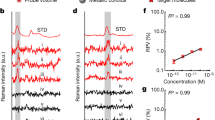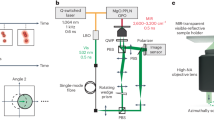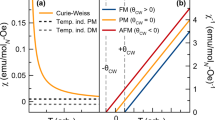Abstract
The use of contrast agents and tracers in medical imaging has a long history1,2,3,4,5,6,7. They provide important information for diagnosis and therapy, but for some desired applications, a higher resolution is required than can be obtained using the currently available medical imaging techniques. Consider, for example, the use of magnetic tracers in magnetic resonance imaging: detection thresholds for in vitro8 and in vivo9 imaging are such that the background signal from the host tissue is a crucial limiting factor. A sensitive method for detecting the magnetic particles directly is to measure their magnetic fields using relaxometry10; but this approach has the drawback that the inverse problem (associated with transforming the data into a spatial image) is ill posed and therefore yields low spatial resolution. Here we present a method for obtaining a high-resolution image of such tracers that takes advantage of the nonlinear magnetization curve of small magnetic particles. Initial ‘phantom’ experiments are reported that demonstrate the feasibility of the imaging method. The resolution that we achieve is already well below 1 mm. We evaluate the prospects for further improvement, and show that the method has the potential to be developed into an imaging method characterized by both high spatial resolution as well as high sensitivity.
This is a preview of subscription content, access via your institution
Access options
Subscribe to this journal
Receive 51 print issues and online access
$199.00 per year
only $3.90 per issue
Buy this article
- Purchase on Springer Link
- Instant access to full article PDF
Prices may be subject to local taxes which are calculated during checkout




Similar content being viewed by others
References
Hevesy, G. Radioelements as tracers in physics and chemistry. Chem. News J. Phys. Sci. 108, 166–167 (1913)
Haschek, E. & Lindenthal, O. A contribution to the practical use of photography according to Roentgen. Wien. Klin. Wschr. 9, 63–64 (1896)
Fye, W. B. The coronary angiogram and its seminal contribution to cardiovascular medicine over five decades. Circulation 106, 752–756 (2002)
Hendrick, R. E. & Haacke, E. M. Basic physics of MR contrast agents and maximization of image contrast. J. Magn. Reson. Imaging 3, 137–148 (1993)
Goldberg, B. B., Liu, J. B. & Forsberg, F. Ultrasound contrast agents: a review. Ultrasound Med. Biol. 20, 319–333 (1994)
Czernin, J. & Phelps, M. E. Position emission tomography scanning: current and future applications. Annu. Rev. Med. 53, 89–112 (2002)
Weissleder, R. & Ntziachristos, V. Shedding light onto live molecular targets. Nature Med. 9, 123–128 (2003)
Heyn, C., Bowen, C. V., Rutt, B. K. & Foster, P. J. Detection threshold of single SPIO-labelled cells with FIESTA. Magn. Reson. Med. 53, 312–320 (2005)
Nunn, A. D., Linder, K. E. & Tweedle, M. F. Can receptors be imaged with MRI agents? Q. J. Nucl. Med. 41, 155–162 (1997)
Romanus, E. et al. Magnetic nanoparticle relaxation measurement as a novel tool for in vivo diagnostics. J. Magn. Magn. Matter 252, 387–389 (2002)
Lawaczek, R. et al. Magnetic iron oxide particles coated with carboxydextran for parenteral administration and liver contrasting. Pre-clinical profile of SH U555A. Acta Radiol. 38, 584–597 (1997)
Chikazumi, S. & Charap, S. H. Physics of Magnetism (Wiley, New York, 1964)
Weissleder, R. et al. Superparamagnetic iron oxide: pharmacokinetics and toxicity. Am. J. Roentgenol. 152, 167–173 (1989)
Vlaardingerbroek, M. T. & den Boer, J. A. Magnetic Resonance Imaging Ch. 6.4 (Springer, Berlin, 2003)
Gleich, B. Method for local heating by means of magnetic particles. World patent WO200418039 (4 March 2004).
Jordan, A. et al. Effects of magnetic fluid hyperthermia (MFH) on C3H mammary carcinoma in vivo. Int. J. Hyperthermia 13, 587–605 (1997)
Press, W. H., Teukolsky, S. A., Vetterling, W. T. & Flannery, B. P. Numerical Recipes in C (Cambridge Univ. Press, 1992)
Author information
Authors and Affiliations
Corresponding authors
Ethics declarations
Competing interests
Reprints and permissions information is available at npg.nature.com/reprintsandpermissions. The authors declare no competing financial interests.
Rights and permissions
About this article
Cite this article
Gleich, B., Weizenecker, J. Tomographic imaging using the nonlinear response of magnetic particles. Nature 435, 1214–1217 (2005). https://doi.org/10.1038/nature03808
Received:
Accepted:
Issue Date:
DOI: https://doi.org/10.1038/nature03808
This article is cited by
-
System characterization of a human-sized 3D real-time magnetic particle imaging scanner for cerebral applications
Communications Engineering (2024)
-
Spatially selective delivery of living magnetic microrobots through torque-focusing
Nature Communications (2024)
-
Harmonic dependence of thermal magnetic particle imaging
Scientific Reports (2023)
-
iMPI: portable human-sized magnetic particle imaging scanner for real-time endovascular interventions
Scientific Reports (2023)
-
Real-time multi-contrast magnetic particle imaging for the detection of gastrointestinal bleeding
Scientific Reports (2023)
Comments
By submitting a comment you agree to abide by our Terms and Community Guidelines. If you find something abusive or that does not comply with our terms or guidelines please flag it as inappropriate.



